R.R.O. 1990, Reg. 726: PROCESSED EGG, Livestock and Livestock Products Act, R.S.O. 1990, c. L.20
Livestock and Livestock Products Act
R.R.O. 1990, REGULATION 726
PROCESSED EGG
Historical version for the period May 17, 2010 to June 30, 2010.
Note: This Regulation is revoked on July 1, 2010. See: O. Reg. 173/10, ss. 1, 2.
Last amendment: O. Reg. 173/10.
This is the English version of a bilingual regulation.
CONTENTS
Sections | ||
1-23 | ||
Pasteurization requirements |
||
Processed egg — application for a licence for operation of a processed egg station |
||
Processed egg — licence for operation of a processed egg station |
||
Application for a licence to sell inedible eggs or inedible processed egg |
||
Licence to sell inedible eggs or inedible processed egg |
||
Application for licence to purchase inedible eggs or inedible processed egg |
||
Licence to purchase inedible eggs or inedible processed egg |
||
Processed egg — notice of detention |
||
Processed egg — notice of release from detention |
||
Processed egg — processed egg under detention |
1. In this Regulation,
“added ingredients” means salt or sugar or both; (“ingrédients supplémentaires”)
“blood spot” means a small particle of blood on the yolk or in the albumen; (“tache de sang”)
“candling” means examination of the internal condition of an egg by rotating it in front of or over a source of light that illuminates the contents; (“mirage”)
“code mark” means a combination of letters, symbols and numbers that identifies an inspector; (“numéro de code”)
“common name” means,
(a) frozen albumen, frozen whole egg, frozen yolk, frozen whole egg mix or frozen yolk mix, or
(b) liquid albumen, liquid whole egg, liquid yolk, liquid whole egg mix or liquid yolk mix; (“nom usuel”)
“consumer” means a person who buys processed egg for personal use and the use of his or her household and not for resale; (“consommateur”)
“container” means any receptacle made or used to contain processed egg; (“contenant”)
“egg” means an egg,
(a) of the domestic chicken of the species Gallus Domesticus, or
(b) of the domestic turkey of the species Meleagris Gallopavo,
but does not include a partly formed egg that has been removed from a slaughtered domestic hen or domestic turkey; (“oeuf”)
“egg solid” means egg yolk or albumen, or a combination thereof, that contains no shell or water; (“solide d’oeuf”)
“egg station” means premises for the grading, packing and marking of eggs; (“poste d’oeufs”)
“food colour” means beta-carotene; (“colorant alimentaire”)
“frozen egg” means whole egg, egg yolk or albumen in frozen form; (“oeuf congelé”)
“inedible egg” means an egg that is not suitable for human consumption and includes an egg that,
(a) is contaminated with an odour foreign to that of a normal egg,
(b) is musty or mouldy,
(c) has been in an incubator, or
(d) has any internal defect other than a meat spot or blood spot less than ⅛ inch diameter; (“oeuf non comestible”)
“inedible processed egg” means processed egg that contains any inedible egg or that is otherwise not suitable for human consumption; (“oeuf transformé non comestible”)
“leaker” means an egg from which the contents are leaking; (“oeuf qui coule”)
“liquid egg” means whole egg, whole egg mix, egg yolk, egg yolk mix or albumen in liquid or semi-liquid form; (“oeuf liquide”)
“meat spot” means a small particle of oviduct on the yolk or in the albumen of the egg; (“tache de chair”)
“mix” means whole egg mix and yolk mix; (“mélange”)
“process” includes breaking eggs, filtering, blending, pasteurizing, stabilizing, mixing, cooling and freezing processed egg; (“transformation”)
“processed egg” includes frozen egg, frozen egg mix, liquid egg and liquid egg mix, but does not include inedible processed egg; (“oeuf transformé”)
“processed egg station” means premises where processed egg is produced, graded, packed or marked; (“poste d’oeufs transformés”)
“registered processed egg station” means a processed egg station that has been licensed under this Regulation; (“poste enregistré d’oeufs transformés”)
“retailer” means a person who offers or has in possession for sale, or sells processed egg to a consumer; (“détaillant”)
“sanitizing agent” means a substance that destroys bacteria on eggs and that has a strength of between 100 and 200 parts per million of available chlorine or its equivalent; (“disinfectant”)
“whole egg mix” means frozen whole egg or liquid whole egg and one or more added ingredients not exceeding 12 per cent by weight; (“mélange d’oeufs entiers”)
“wholesaler” means any person who sells processed egg to a retailer or to any person for use as food or in the preparation of food for human consumption; (“grossiste”)
“yolk mix” means frozen yolk or liquid yolk and one or more added ingredients not exceeding 12 per cent by weight. (“mélange de jaunes d’oeufs”) R.R.O. 1990, Reg. 726, s. 1.
2. Processed egg is designated as a livestock product. R.R.O. 1990, Reg. 726, s. 2.
3. Dealers in processed egg, except operators of processed egg stations and buyers or sellers of inedible processed egg, are exempt from section 2 of the Act. R.R.O. 1990, Reg. 726, s. 3.
4. (1) No person shall sell, offer for sale, purchase, receive, store, ship or transport within Ontario processed egg for human consumption, except processed egg graded, packed and marked in accordance with this Regulation. R.R.O. 1990, Reg. 726, s. 4 (1).
(2) Where processed egg is stored on the premises of a retailer or wholesaler, whether or not in view of the public, it shall be deemed to be for sale. R.R.O. 1990, Reg. 726, s. 4 (2).
5. (1) An application for a licence to operate a processed egg station shall be in Form 1. R.R.O. 1990, Reg. 726, s. 5 (1).
(2) A licence to operate a processed egg station shall be in Form 2. R.R.O. 1990, Reg. 726, s. 5 (2).
(3) The conditions under which a licence in Form 2 may be issued are that the premises be constructed and inspected and found to comply with the requirements of this Regulation. R.R.O. 1990, Reg. 726, s. 5 (3).
(4) The fee for a licence in Form 2 is $1 and shall be forwarded with the application for the licence. R.R.O. 1990, Reg. 726, s. 5 (4).
(5) A licence in Form 2 is not transferable and shall remain in force unless,
(a) it is suspended or cancelled by the Commissioner; or
(b) there is no processed egg graded, packed or marked in the station for a period of twelve consecutive months. R.R.O. 1990, Reg. 726, s. 5 (5).
6. (1) An application for a licence to sell inedible processed egg shall be in Form 3. R.R.O. 1990, Reg. 726, s. 6 (1).
(2) A licence to sell inedible processed egg shall be in Form 4. R.R.O. 1990, Reg. 726, s. 6 (2).
(3) A licence in Form 4 shall be issued without charge, is not transferable and remains in force unless suspended or cancelled by the Commissioner. R.R.O. 1990, Reg. 726, s. 6 (3).
(4) The conditions under which a licence to sell inedible processed egg shall be issued are,
(a) that the holder of the licence make a record with respect to the sale of all inedible processed egg showing,
(i) the name and address of each purchaser of each lot of inedible processed egg sold,
(ii) the quantity by weight of inedible processed egg in each lot, and
(iii) the date of selling,
and retain the record for not less than ninety days from the making thereof; and
(b) that the holder of the licence mark all containers in which the holder ships or transports inedible processed egg by printing, stamping or stencilling the top and one side with the words “Not For Human Consumption” in letters at least one and one-half inches high and the licence number of the registered processed egg station in letters at least ⅜ of an inch high. R.R.O. 1990, Reg. 726, s. 6 (4).
7. (1) An application for a licence to purchase inedible processed egg shall be in Form 5. R.R.O. 1990, Reg. 726, s. 7 (1).
(2) A licence to purchase inedible processed egg shall be in Form 6. R.R.O. 1990, Reg. 726, s. 7 (2).
(3) A licence in Form 6 shall be issued without charge, is not transferable and remains in force unless suspended or cancelled by the Commissioner. R.R.O. 1990, Reg. 726, s. 7 (3).
(4) The condition under which a licence in Form 6 is issued is that the holder of the licence furnish to the Commissioner a statement showing,
(a) the quantities of all inedible processed egg purchased or otherwise obtained during each calendar month;
(b) the name and address of the person from whom the inedible processed egg was purchased or otherwise obtained, and the date of purchasing or otherwise obtaining the inedible processed egg; and
(c) the purpose for which the inedible processed egg was purchased or otherwise obtained,
not later than the 15th day of the month next following. R.R.O. 1990, Reg. 726, s. 7 (4).
8. Premises where eggs are processed for human consumption shall be constructed, maintained and operated in compliance with the following conditions:
1. Every room comprising the station is sound in construction, clean and in good repair.
2. The station has separate rooms, where applicable, for,
i. receiving, holding and storing eggs,
ii. washing, candling and transferring eggs to the processing equipment,
iii. processing eggs,
iv. packaging liquid processed egg,
v. holding liquid egg,
vi. freezing processed egg, and
vii. inspection of processed egg by an inspector if such a room is required by the District Director, Poultry Division, Agriculture Canada.
3. The floors, walls, and ceilings of the station are impervious to moisture and are of a hard finish suitable for cleaning.
4. The station has dressing rooms and lavatories that are,
i. adequate in size and equipment for the number of persons using them,
ii. well lighted and vented to the outside, and
iii. separate from and not leading directly into any room used for the processing of eggs.
5. The station has drainage, plumbing and sewage that are,
i. adequate to handle all wastes,
ii. equipped with suitable traps and vents, and
iii. designed for the rapid runoff of water within the station.
6. The station is adequately lighted.
7. The station is protected against the entrance of flies, rodents and vermin.
8. The doors to the rooms used for processing eggs are equipped with self-closing devices.
9. The size and arrangement of rooms and equipment in the station are adequate for the volume of processed egg handled.
10. All rooms in the station except cold storage rooms are ventilated by a continuous flow of clean air.
11. The processing and packaging rooms in the station are ventilated by a positive flow of outside filtered air.
12. The station has an ample supply of potable hot and cold water under adequate pressure in all washrooms, lavatories and rooms in which eggs or processed egg are handled.
13. The processing room in the station is equipped with,
i. readily accessible equipment for washing hands including odourless soap, towels or other means for drying hands, and
ii. covered receptacles in which to place rejected eggs and rejected liquid egg.
14. The station has mechanical refrigeration equipment that is suitable for cooling and storing liquid egg, where liquid egg is processed or stored.
15. Utensils and equipment used in processing and packing processed egg are,
i. made of material that is resistant to rust and corrosion,
ii. designed and constructed to permit them to be easily cleaned and sterilized,
iii. sterilized before use each day,
iv. washed with a sterilizing solution after every four hours of use and at the end of each day’s operation, and
v. drained and dried at the end of each day’s operation.
16. Egg washing and candling equipment in the station is efficient and may be easily cleaned.
17. No eggs are washed in a room used for processing eggs.
18. The eggs used to make processed egg have been washed in clean water,
i. that is maintained at not less than 32.2 degrees Celsius and at least 11.1 degrees warmer than the egg,
ii. in which a cleaning compound is used,
iii. in which the eggs are washed continuously,
iv. that is changed at least every four hours and at the end of each shift, and
v. that is maintained at a level which permits a continuous overflow.
19. The eggs after being washed and immediately before being further processed are spray-rinsed with a sanitizing agent.
20. Egg shells are removed from the processing room either by continuous process or at least four times daily.
21. Every utensil or other equipment that comes into contact with an inedible egg or inedible processed egg is washed with a sterilizing solution before being used again.
22. Every person employed in the station wears clean clothing, including a hair covering that completely covers the hair.
23. Every person employed in the station is free from communicable disease and for that purpose shall, if so required by an inspector, be medically examined.
24. Smoking and the chewing of tobacco or gum are not permitted in any room in the station in which eggs are exposed in liquid or semi-liquid form.
25. Every person in the station who handles processed egg washes his or her hands and rinses them thoroughly in a non-irritating disinfectant solution each time on entering the processing room and immediately after handling any inedible egg or inedible processed egg.
26. Inedible eggs and inedible processed egg are placed in a container bearing the words “not for human consumption”.
27. Nothing that is likely to emit an odour that could affect the flavour of processed egg is held in the station.
28. Containers are,
i. if of washable material, thoroughly washed, rinsed, drained and sterilized before being packed in the station,
ii. not nested one within another, and
iii. not placed on the floor of the station at any time either before or after being packed.
29. Pumps, homogenizers and pasteurizers of the processing equipment are cleaned in place or dismantled, cleaned and sanitized after use, and at other times when necessary.
30. The processed egg meets the requirements for pasteurization set out in the Schedule.
31. Egg shell receptacles and equipment for disposing of egg shells are maintained clean and sanitary.
32. Every container received at the station is free from dirt and residue of eggs.
33. Except with the written approval of the District Director, Poultry Division, Agriculture Canada, processed egg in liquid form is not removed from the station unless cooled to not more than 4.4 degrees Celsius.
34. Frozen egg is frozen solid or cooled to at least -12 degrees Celsius,
i. within sixty hours from the time of breaking where it has not been pasteurized, or
ii. within sixty hours from the time of pasteurization where it has been pasteurized.
35. The processed egg is processed and packed in a sanitary manner.
36. No processed egg is received at the station unless it has been graded, packed, and marked in accordance with this Regulation. R.R.O. 1990, Reg. 726, s. 8.
9. The following grade names for processed egg and the grades and standards therefor, established under the Canada Agricultural Products Act, are adopted in whole:
1. Canada A.
2. Canada B.
3. Canada C. R.R.O. 1990, Reg. 726, s. 9.
10. Processed egg may be graded only if it is prepared from eggs,
(a) that are free from excessive stain;
(b) none of which is an inedible egg or a leaker; and
(c) that are free from dirt and other foreign matter. R.R.O. 1990, Reg. 726, s. 10.
11. For the purpose of section 10, excessive stain means any substance on the shell of an egg other than dirt or a design or emblem that exceeds one-third of the surface of the shell. R.R.O. 1990, Reg. 726, s. 11.
12. (1) Processed egg shall only be graded in a registered processed egg station. R.R.O. 1990, Reg. 726, s. 12 (1).
(2) Processed egg may be graded only if it has been prepared in a registered processed egg station. R.R.O. 1990, Reg. 726, s. 12 (2).
13. (1) Every container of processed egg graded under this Regulation shall be clean, free from discolouration and objectionable odours, strong enough to protect the processed egg and, if made of corrugated fibreboard, shall be new. R.R.O. 1990, Reg. 726, s. 13 (1).
(2) Liners used in containers shall be new. R.R.O. 1990, Reg. 726, s. 13 (2).
(3) Processed egg may be packed in a container only with processed egg of the same form, kind and grade. R.R.O. 1990, Reg. 726, s. 13 (3).
14. (1) Except as otherwise provided, every container of processed egg shall be marked with,
(a) the common name of the processed egg;
(b) the grade name of the processed egg;
(c) the net quantity of the processed egg;
(d) the common names of ingredients and components of the processed egg;
(e) the words “lot number” followed by a series of numbers which, according to common usage, indicate the day, month and year in which the processed egg was prepared, and a number or letter identifying the batch if more than one batch was prepared on the same day;
(f) the identity and principal place of business of the person by or for whom the processed egg was manufactured or produced for resale;
(g) the words “reg. no.” followed by the licence number of the registered processed egg station in which the processed egg was prepared;
(h) if food colour has been added, the words “contains colour” or “colour added”; and
(i) where the processed egg was prepared from eggs of the domestic turkey and eggs of the domestic chicken, the words “product of turkey eggs” or “product of turkey eggs and chicken eggs”, as the case may be. R.R.O. 1990, Reg. 726, s. 14 (1).
(2) The information required by subsection (1) shall be printed, stamped or stencilled on the side of the container. R.R.O. 1990, Reg. 726, s. 14 (2).
(3) The printing, stamping or stencilling of markings required by subsection (1) shall be applied in such a manner that the processed egg will bear the markings at the time it is sold. R.R.O. 1990, Reg. 726, s. 14 (3).
(4) The numerical quantity in the declaration of net quantity and the words “Canada A”, “Canada B” or “Canada C” in a grade name or grade designation shall be shown in bold face type in letters of not less than ⅜ of an inch in height and, where the grade name is Canada A or Canada B, the grade shall be shown enclosed within a design of a maple leaf as illustrated in the following example:

R.R.O. 1990, Reg. 726, s. 14 (4).
(5) Where the processed egg is graded Canada C, the outline of the maple leaf shall not be used on the container and the grade name shall be shown as illustrated in the following example:

R.R.O. 1990, Reg. 726, s. 14 (5).
(6) All information other than the information referred to in subsection (4) shall be shown in letters of not less than ¼ of an inch in height. R.R.O. 1990, Reg. 726, s. 14 (6).
(7) No container of processed egg graded pursuant to this Regulation shall be marked with any word or words declaring or implying that the processed egg packed therein is superior in quality to the grade marked thereon. R.R.O. 1990, Reg. 726, s. 14 (7).
15. (1) An inspector may at the time processed egg is produced or at any time thereafter select samples from each lot of processed egg produced by a registered processed egg station. R.R.O. 1990, Reg. 726, s. 15 (1).
(2) The number of containers in a lot to be selected for sampling shall be determined in accordance with the following Table:
TABLE
Column I |
Column II |
No. of Containers in Lot |
Minimum No. of Containers to be selected for sampling |
1 – 25 |
4 |
26 – 50 |
4 |
51 – 100 |
6 |
101 – 150 |
8 |
151 – 200 |
10 |
201 – 300 |
12 |
301 – 400 |
14 |
401 – 500 |
16 |
501 – 800 |
18 |
801 – 1000 |
20 |
1001 and up |
1 per cent of Total. |
R.R.O. 1990, Reg. 726, s. 15 (2).
16. (1) Every person operating a registered processed egg station shall make a report each week to the District Director, Poultry Division, Agriculture Canada on a form approved by the Minister of Agriculture for Canada stating,
(a) the quantity of processed egg graded during that week, classified in the manner required by the form;
(b) the quantity of eggs used in preparing processed egg during that week, classified as to grades; and
(c) such other information as may be indicated on the form. R.R.O. 1990, Reg. 726, s. 16 (1).
(2) A person operating a registered processed egg station shall furnish to the District Director, Poultry Division, Agriculture Canada at his or her request and in respect of any period designated by the Director, information relating to the quantity of eggs, and the number of containers of processed egg received, sold, shipped and on hand at the processed egg station during that period. R.R.O. 1990, Reg. 726, s. 16 (2).
17. (1) No person shall advertise processed egg for sale unless the advertisement contains a statement in a prominent position therein setting out the grade name of the processed egg advertised. R.R.O. 1990, Reg. 726, s. 17 (1).
(2) In any advertisement pertaining to processed egg wherein the price appears, the grade name shall be stated in letters of at least equal size and prominence to the price. R.R.O. 1990, Reg. 726, s. 17 (2).
(3) No person shall in any advertisement offering processed egg for sale,
(a) make any untrue, deceptive or misleading statement or implication; or
(b) use words or phrases implying that the processed egg of the grade advertised is superior in condition or quality to that required for processed egg of that grade. R.R.O. 1990, Reg. 726, s. 17 (3).
18. (1) The operator of a registered processed egg station shall maintain and be responsible for complete records of all purchases of eggs used for the production of processed egg and purchases of processed egg from other registered stations. R.R.O. 1990, Reg. 726, s. 18 (1).
(2) The records pertaining to purchases of eggs and processed egg shall show,
(a) the name and address of the person from whom the eggs were received;
(b) the name and address of the registered processed egg station from whom the processed egg was received;
(c) the date of receipt;
(d) the quantity of eggs or quantity and weight of processed egg;
(e) the unit price to be paid for the eggs or for the weight of processed egg; and
(f) the total value of the eggs or processed egg. R.R.O. 1990, Reg. 726, s. 18 (2).
(3) The operator of a registered processed egg station shall retain at the operator’s place of business the records required by subsections (1) and (2) for a period of ninety days. R.R.O. 1990, Reg. 726, s. 18 (3).
19. An inspector may place under detention any processed egg that does not comply with the Act and this Regulation by affixing to at least one container of the lot a detention tag in Form 9. R.R.O. 1990, Reg. 726, s. 19.
20. The inspector shall, after affixing a detention tag under section 19 immediately deliver or mail to the owner of the processed egg seized, or the owner’s agent, and to the occupier of the premises where it was detained, a notice of detention in Form 7. R.R.O. 1990, Reg. 726, s. 20.
21. Unless authorized by an inspector, no person shall alter or remove a detention tag affixed to a container of processed egg under section 19. R.R.O. 1990, Reg. 726, s. 21.
22. Except with the written permission of an inspector, no person shall remove, sell, or otherwise dispose of any processed egg contained in a lot in respect of which a detention tag has been placed on a container under section 19. R.R.O. 1990, Reg. 726, s. 22.
23. An inspector who is satisfied that processed egg held under detention complies with this Regulation shall complete a notice of release from detention in Form 8, and shall deliver or mail one copy to the owner of the processed egg and one copy to the person on whose premises the processed egg was detained. R.R.O. 1990, Reg. 726, s. 23.
SCHEDULE
PASTEURIZATION REQUIREMENTS
Processed egg shown in Column 1 must be heated at not less than the temperature shown in Column 2 for not less than the corresponding time shown in Column 3.
Column 1 |
Column 2 |
Column 3 |
Liquid Egg |
Minimum Temperature |
Minimum Time to be heated |
Degrees Celsius |
Minutes | |
Albumen (without use of chemicals) |
55 |
3.5 |
or 53 |
6.2 | |
Whole egg |
60 |
3.5 |
Whole egg with 24.75 per cent to 38 per cent egg solids |
61 |
3.5 |
or 60 |
6.2 | |
Mix with 2 per cent or more added salt |
63 |
3.5 |
or 62 |
6.2 | |
Mix with 2 per cent to 12 per cent added sugar |
61 |
3.5 |
or 60 |
6.2 | |
Mix with not more than 2 per cent added ingredients |
61 |
3.5 |
or 60 |
6.2 | |
Mix with 24.5 per cent to 38 per cent egg solids and 2 per cent to 12 per cent added ingredients |
62 |
3.5 |
or 61 |
6.2 | |
Yolk |
61 |
3.5 |
or 60 |
6.2 | |
Yolk with 2 per cent or more added sugar |
63 |
3.5 |
or 62 |
6.2 | |
Yolk with 2 per cent to 12 per cent added salt |
63 |
3.5 |
or 62 |
6.2 |
R.R.O. 1990, Reg. 726, Sched.
FORM 1
PROCESSED EGG — APPLICATION FOR A LICENCE FOR OPERATION OF A PROCESSED EGG STATION
Livestock and Livestock Products Act


R.R.O. 1990, Reg. 726, Form 1.
FORM 2
PROCESSED EGG — LICENCE FOR OPERATION OF A PROCESSED EGG STATION
Livestock and Livestock Products Act
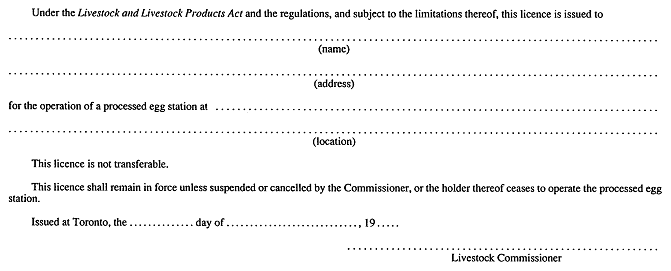
R.R.O. 1990, Reg. 726, Form 2.
FORM 3
APPLICATION FOR A LICENCE TO SELL INEDIBLE EGGS OR INEDIBLE PROCESSED EGG
Livestock and Livestock Products Act


R.R.O. 1990, Reg. 726, Form 3.
FORM 4
LICENCE TO SELL INEDIBLE EGGS OR INEDIBLE PROCESSED EGG
Livestock and Livestock Products Act
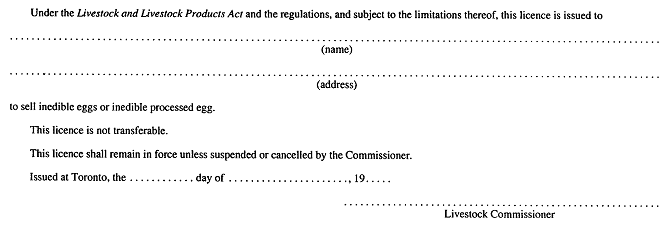
R.R.O. 1990, Reg. 726, Form 4.
FORM 5
APPLICATION FOR LICENCE TO PURCHASE INEDIBLE EGGS OR INEDIBLE PROCESSED EGG
Livestock and Livestock Products Act
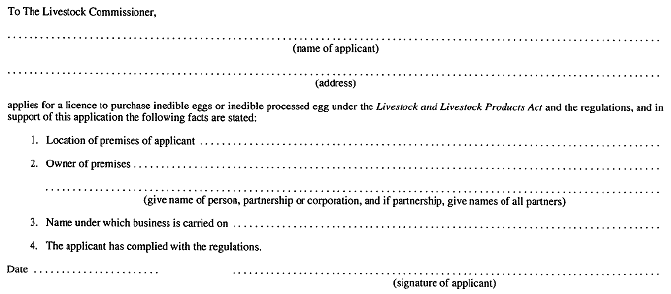
R.R.O. 1990, Reg. 726, Form 5.
FORM 6
LICENCE TO PURCHASE INEDIBLE EGGS OR INEDIBLE PROCESSED EGG
Livestock and Livestock Products Act
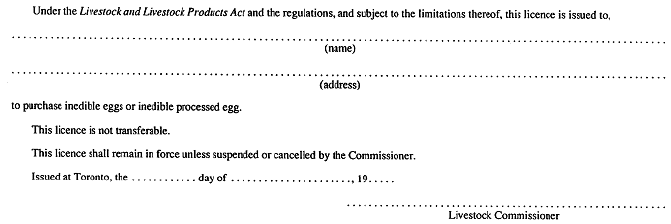
R.R.O. 1990, Reg. 726, Form 6.
FORM 7
PROCESSED EGG — NOTICE OF DETENTION
Livestock and Livestock Products Act
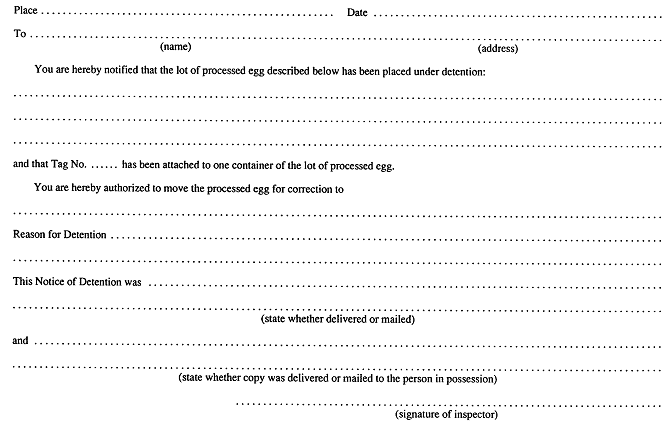
R.R.O. 1990, Reg. 726, Form 7.
FORM 8
PROCESSED EGG — NOTICE OF RELEASE FROM DETENTION
Livestock and Livestock Products Act

R.R.O. 1990, Reg. 726, Form 8.
FORM 9
PROCESSED EGG — PROCESSED EGG UNDER DETENTION
Livestock and Livestock Products Act

R.R.O. 1990, Reg. 726, Form 9.